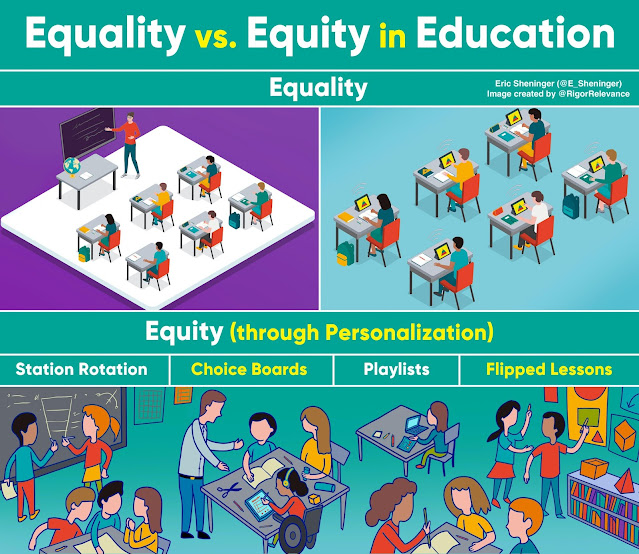When it comes to blended learning, it is essential first to have an underlying understanding as to why this pedagogical strategy is valuable in the classroom. Let’s take a step back before diving into the nuts and bolts. Over the years, I have written a great deal about personalization, which is basically a shift from “what” to “who” as a means for students to demonstrate more ownership over their learning. What is taught or on the test has little value if the diverse needs of learners aren’t addressed. The same could be said if all kids are learning the same thing at the same time in the same way.
The path to equity begins with a vision where all learners get what they need when and where they need it, regardless of the learning environment. This is the essence of personalization. While there are many strategies to personalize, blended pedagogies represent the most practical means. While you don’t need technology to personalize, it is required to blend. Here is my definition shared in Disruptive Thinking in Our Classrooms that makes a distinction between instruction:
Blended instruction is what the teacher does with technology. Blended learning is where students use tech to have control over path, place, and pace.
Over time through my extensive work with schools, I have identified the four most practical ways to personalize through blended learning. These include station rotation, choice activities, playlists, and the flipped approach. While each has unique benefits, they all help move teaching and learning from a state of equality to equity. The image below is my attempt to capture these significant changes.
I realized that I have separate posts and images on all four of these blended learning strategies and thought it might be a good idea to curate this information that educators have found valuable to create a resource. Below I have briefly summarized each approach and encourage you to click on the link for more detailed information.
Students are grouped based on data and move through a variety of set activities typically consisting of targeted instruction with the teacher, collaborative exercises, independent work, and online tasks that are personalized for individual learners. The teacher establishes a block of time for each station, and students visit each one during a class period followed by some sort of forma¬tive assessment.
These allow students to select a set number of activities to complete from numerous options. Typically, they are arranged in a choice board or must-do/may-do format. Often a teacher will differentiate by having different versions. Students do not complete all of the activities.
A series of individualized assignments that students work through at their own pace while following the path of their choice. As students complete a task, they either color in the corre¬sponding box on a digital sheet next to their name or check off each box on a paper worksheet. Unlike choice activities, all tasks are completed.
Students watch a short, direct instruction video or consume other forms of content outside of school at their own pace while communicating with peers and teachers using online tools. While in school, students work to actively apply what they have learned through concept engagement and empowering learning activities with assistance from the teacher.
All the blended learning strategies listed above allow educators to better use their time with students while opening the door to more significant equity through personalization. It is important to remember that instruction still plays an important role, especially in terms of setting up the blended pathway of choice. It is up to the teacher to determine when and the extent to which each strategy is implemented.





No comments:
Post a Comment